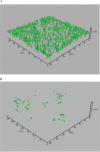Long-Term Survival of Virulent Tularemia Pathogens outside a Host in Conditions That Mimic Natural Aquatic Environments
- PMID: 33397692
- PMCID: PMC8104992
- DOI: 10.1128/AEM.02713-20
Long-Term Survival of Virulent Tularemia Pathogens outside a Host in Conditions That Mimic Natural Aquatic Environments
Abstract
Francisella tularensis, the causative agent of the zoonotic disease tularemia, can cause seasonal outbreaks of acute febrile illness in humans with disease peaks in late summer to autumn. Interestingly, its mechanisms for environmental persistence between outbreaks are poorly understood. One hypothesis is that F. tularensis forms biofilms in aquatic environments. We utilized two fully virulent wild-type strains: FSC200 (Francisella tularensis subsp. holarctica) and Schu S4 (Francisella tularensis subsp. tularensis) and three control strains, the attenuated live vaccine strain (LVS; F. tularensis subsp. holarctica), a Schu S4 ΔwbtI mutant that is documented to form biofilms, and the low-virulence strain U112 of the closely related species Francisella novicida Strains were incubated in saline solution (0.9% NaCl) microcosms for 24 weeks at both 4°C and 20°C, whereupon viability and biofilm formation were measured. These temperatures were selected to approximate winter and summer temperatures of fresh water in Scandinavia, respectively. U112 and Schu S4 ΔwbtI formed biofilms, but F. tularensis strains FSC200 and Schu S4 and the LVS did not. All strains exhibited prolonged viability at 4°C compared to 20°C. U112 and FSC200 displayed remarkable long-term persistence at 4°C, with only 1- and 2-fold log reductions, respectively, of viable cells after 24 weeks. Schu S4 exhibited lower survival, yielding no viable cells by week 20. At 24 weeks, cells from FSC200, but not from Schu S4, were still fully virulent in mice. Taken together, these results demonstrate biofilm-independent, long-term survival of pathogenic F. tularensis subsp. holarctica in conditions that mimic overwinter survival in aquatic environments.IMPORTANCE Tularemia, a disease caused by the environmental bacterium Francisella tularensis, is characterized by acute febrile illness. F. tularensis is highly infectious: as few as 10 organisms can cause human disease. Tularemia is not known to be spread from person to person. Rather, all human infections are independently acquired from the environment via the bite of blood-feeding arthropods, ingestion of infected food or water, or inhalation of aerosolized bacteria. Despite the environmental origins of human disease events, the ecological factors governing the long-term persistence of F. tularensis in nature between seasonal human outbreaks are poorly understood. The significance of our research is in identifying conditions that promote long-term survival of fully virulent F. tularensis outside a mammalian host or insect vector. These conditions are similar to those found in natural aquatic environments in winter and provide important new insights on how F. tularensis may persist long-term in the environment.
Keywords: Francisella tularensis; aquatic environment; biofilms; long-term persistence; tularemia.
Copyright © 2021 Golovliov et al.
Figures




Similar articles
-
Live Attenuated Tularemia Vaccines for Protection Against Respiratory Challenge With Virulent F. tularensis subsp. tularensis.Front Cell Infect Microbiol. 2018 May 15;8:154. doi: 10.3389/fcimb.2018.00154. eCollection 2018. Front Cell Infect Microbiol. 2018. PMID: 29868510 Free PMC article. Review.
-
A ΔclpB mutant of Francisella tularensis subspecies holarctica strain, FSC200, is a more effective live vaccine than F. tularensis LVS in a mouse respiratory challenge model of tularemia.PLoS One. 2013 Nov 13;8(11):e78671. doi: 10.1371/journal.pone.0078671. eCollection 2013. PLoS One. 2013. PMID: 24236032 Free PMC article.
-
Impact of Francisella tularensis pilin homologs on pilus formation and virulence.Microb Pathog. 2011 Sep;51(3):110-20. doi: 10.1016/j.micpath.2011.05.001. Epub 2011 May 13. Microb Pathog. 2011. PMID: 21605655 Free PMC article.
-
A Francisella tularensis locus required for spermine responsiveness is necessary for virulence.Infect Immun. 2011 Sep;79(9):3665-76. doi: 10.1128/IAI.00135-11. Epub 2011 Jun 13. Infect Immun. 2011. PMID: 21670171 Free PMC article.
-
Comparative review of Francisella tularensis and Francisella novicida.Front Cell Infect Microbiol. 2014 Mar 13;4:35. doi: 10.3389/fcimb.2014.00035. eCollection 2014. Front Cell Infect Microbiol. 2014. PMID: 24660164 Free PMC article. Review.
Cited by
-
Why vary what's working? Phase variation and biofilm formation in Francisella tularensis.Front Microbiol. 2022 Dec 6;13:1076694. doi: 10.3389/fmicb.2022.1076694. eCollection 2022. Front Microbiol. 2022. PMID: 36560950 Free PMC article. Review.
-
Tularemia - a re-emerging disease with growing concern.Vet Q. 2023 Dec;43(1):1-16. doi: 10.1080/01652176.2023.2277753. Epub 2023 Nov 18. Vet Q. 2023. PMID: 37916743 Free PMC article.
-
Phase Variation of LPS and Capsule Is Responsible for Stochastic Biofilm Formation in Francisella tularensis.Front Cell Infect Microbiol. 2022 Jan 14;11:808550. doi: 10.3389/fcimb.2021.808550. eCollection 2021. Front Cell Infect Microbiol. 2022. PMID: 35096655 Free PMC article.
-
Phenotypic and transcriptional characterization of F. tularensis LVS during transition into a viable but non-culturable state.Front Microbiol. 2024 Feb 6;15:1347488. doi: 10.3389/fmicb.2024.1347488. eCollection 2024. Front Microbiol. 2024. PMID: 38380104 Free PMC article.
-
Development and evaluation of a rapid RPA/CRISPR-based detection of Francisella tularensis.Front Microbiol. 2022 Aug 10;13:901520. doi: 10.3389/fmicb.2022.901520. eCollection 2022. Front Microbiol. 2022. PMID: 36033876 Free PMC article.
References
-
- Olsufjev NG, Emelyanova OS, Dunaeva TN. 1959. Comparative study of strains of B. tularense in the Old and New World and their taxonomy. Hyg Epidemiol Microbiol Immunol 3:138–149. - PubMed
-
- Hollis DG, Weaver RE, Steigerwalt AG, Wenger JD, Moss CW, Brenner DJ. 1989. Francisella philomiragia comb. nov. (formerly Yersinia philomiragia) and Francisella tularensis biogroup novicida (formerly Francisella novicida) associated with human disease. J Clin Microbiol 27:1601–1608. doi:10.1128/JCM.27.7.1601-1608.1989. - DOI - PMC - PubMed
-
- Huber B, Escudero R, Busse H-J, Seibold E, Scholz HC, Anda P, Kampfer P, Splettstoesser WD. 2010. Description of Francisella hispaniensis sp. nov., isolated from human blood, reclassification of Francisella novicida (Larson et al. 1955) Olsufiev et al. 1959 as Francisella tularensis subsp. novicida comb. nov. and emended description of the genus Franc. Int J Syst Evol Microbiol 60:1887–1896. doi:10.1099/ijs.0.015941-0. - DOI - PubMed
-
- Penn R. 2010. Francisella tularensis (Tularemia), p 2927–2937. In Mandell GL, Bennet JE, Doblin R (ed), Mandell, Douglas and Bennett's principles and practice of infectious diseases, 6th ed. Elsevier Churchill, Livingstone, Philadelphia, PA.
Publication types
MeSH terms
LinkOut - more resources
Full Text Sources
Other Literature Sources

